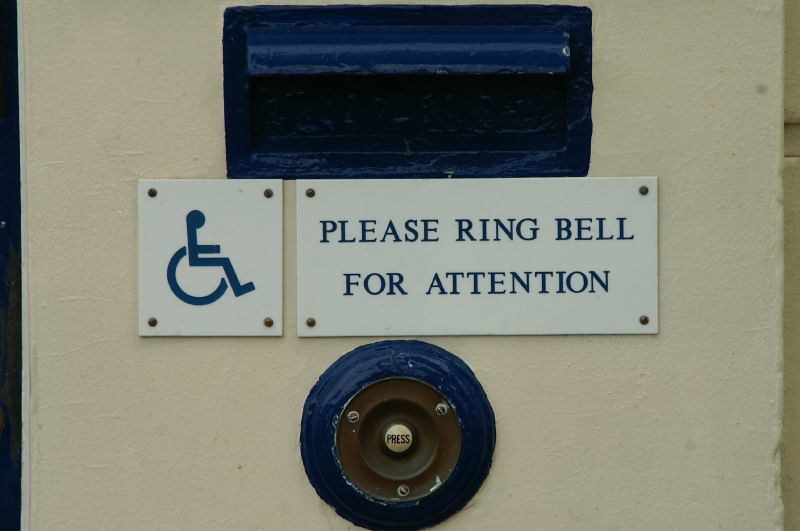This article is part of the Under the Lens series
Not Just Ramps—Disability and Housing Justice

Photo by Flickr user Brenda Gottsabend, CC BY-NC 2.0
When you think of accessible housing, you probably picture the physical aspects of those buildings—wide doorways, cabinets within reach, fire alarms that use both light and sound, and so on.
But accessibility is also determined by management policies—some of which are dictated by funding sources, others of which are dictated by housing providers themselves. Here is a nonexhaustive list of ways in which housing policies can create accessibility barriers.
Limiting Number of Bedrooms
A dearth of affordable apartments large enough for families is a constant concern affecting many households—including families that are trying to stay in appreciating neighborhoods—and groups that are trying to resettle refugee families. It’s even worse for those who need accessible homes, as disabled people are often assumed to be single and childless. While disabled people are more likely than non-disabled people to live alone, 45 percent of disabled people live with two or more other people. Accessible units are disproportionately studios and one-bedrooms, says Jewelles Smith, a Canadian researcher who focuses on disability and gender, and some multi-floor “accessible” townhomes have only an accessible first floor, assuming that the disabled person is not, for example, the caregiver of children or elderly parents who would be using the other bedrooms.
With such a shortage of larger units, it is understandable that housing providers are reluctant to give larger apartments to people who they don’t believe “need” extra bedrooms. Housing providers or agencies that issue housing assistance may even force households to move as soon as their household size changes. These policies have a disproportionately heavy effect on disabled parents and workers, however. Parents who may temporarily not have their children living with them will have a difficult time getting them back if they lose access to a large enough accessible unit. For many immunocompromised people, working from home is an important way to protect themselves from exposure to diseases that could be devastating to their health, but a second bedroom for an office is often not considered a disability accommodation. Neither is having access to a second bedroom for a live-in caregiver.
Punishing Making Do
Even worse, policies in child welfare agencies often punish disabled parents who end up in the system if they are making do in a home that isn’t fully accessible to them, because it was their only option for where to live. If a parent has any interaction with the state—whether seeking housing assistance or other services—there is always a risk of a child welfare investigation if anyone they interact with perceives a safety risk. Unfortunately, when accessible housing is in scarce supply, disabled parents are often forced into imperfect situations that might be viewed that way, especially given the ableism that makes many people question whether disabled people can parent well at all.
“There’s often a trade-off of what is accessible and what is not accessible,” says Smith. One of the women Smith interviewed for a study on disabled moms talked about how her wheelchair doesn’t fit in her house so she gets around with the help of her son’s giant plastic toy truck. Another one struggled to bathe her children in a non-accessible bathroom. “Over and over, I heard about moms who are just trading off different parts of accessibility like, ‘Well, the bedrooms are accessible,’ or ‘Well, it’s more accessible than the last home,’” says Smith. However, she continues, “there’s also this really terrifying thing that if the Ministry of Children and Families finds out that you’re winging it, you can have an investigation, right?”, and if an adaptation is considered a safety problem, the response is often punitive. (In the United States, Child Protective Services can behave in the same way.) Given this risk, disabled parents in these positions are “afraid to say out loud to anybody that they’re struggling,” or ask for modifications, says Smith, “because then, instead of government or landlords fixing it, you can lose your children because they’d rather take your kids away than fix your home.”
Parking Spots
At first blush, not extending a parking space to a non-driver seems reasonable. However, notes Smith, she knows a blind person who has a caregiver who attends to her daily—and yet her housing provider will not allot her a dedicated parking spot, despite the fact that a driver living in that same unit would be assigned one. “She’s like, ‘I literally have somebody come every day for a couple hours, who can’t park anywhere near my unit? Or help me deliver groceries?’” reports Smith.
Emotional Support Animals
While their importance is frequently misunderstood, emotional support animals (ESAs) play a very important role for many people with disabilities, and it is a fair housing violation to ban them, or to charge extra for their presence. State and local laws, and policies and attitudes from housing providers, can make the process either immensely more challenging or more supportive.
“The problem is conflating pet and emotional support animal,” says Tanya Lavelle, policy specialist at Disability Rights Texas. “People who rely on emotional support animals “do not need to have a prescription, but landlords are allowed to ask for proof,” explains Lavelle. If “they get proof [from their doctor], they can keep their animal, they don’t have pet rent, they’re not allowed to be discriminated against because they have an animal. But we still see that a lot.” There is a federal definition, but “in Texas, there’s no actual definition in statute of an emotional support animal,” which Lavelle says would be helpful because Texas Human Resources code already includes rights and prohibitions regarding service and assistance animals, as well as penalties for violating that part of the code. Including ESAs in that code would clarify accommodations for them and spell out enforcement for not providing those accommodations. She is working to get that included.
Owner-Occupancy Rules
Dawn Howard, director of community organizing at Colorado Cross-Disability Commission, owns a home in a community land trust, which she is very happy with. However, she notes that the CLT’s owner-occupancy-only rules—meant to prevent land trust owners from capitalizing on the below-market prices by turning their homes into investment properties—also prevent parents from buying a home for a low-income disabled child who can live independently but is not able to be the homeowner of record. Depending on how they are construed, owner-occupancy rules associated with accessory dwelling units, or ADUs, could run into similar challenges, displacing adult disabled children living in ADUs when their parents pass on if their new guardians don’t want to live in the main house.
Building Operations
Full accommodations for chemical sensitivities start with using healthy building products. But some of the most important accommodations come in the operations of a building, when decisions are made about what products to use in both common spaces and inside units, for cleaning, pest control, odor control, or landscaping. For housing providers that have a lot of units, it’s also important to have a proactive policy of being willing to move households to other units that suit their needs better. This could be for physical accessibility, removal from sources of chemical irritants, or for sensory reasons (either removal from a noise source, or being placed in a unit where any noise generated by self-stimulating activities, known as stims, or other needs doesn’t bother neighbors).
Providing different methods of communication and payment options can make leasing, rent payment, and navigating complaints much more accessible to neurodivergent renters, as well as to those with intellectual or cognitive disabilities. People with social anxiety or auditory processing disorder can benefit from communication options that don’t require phone calls, for example, as well as clear written summaries to follow up on every in-person interaction.
Check Those Policies
It is easy to miss the effects of specific policies and procedures on people with disabilities without hearing the input and perspectives of disabled people themselves. Housing providers and government agencies whose policies affect housing should conduct periodic reviews of their policies for accessibility implications and proactively seek feedback from disabled residents and potential residents while doing so. Seemingly small changes can make a huge difference.
|
Help keep us strong by becoming a Shelterforce supporter. |






Comments